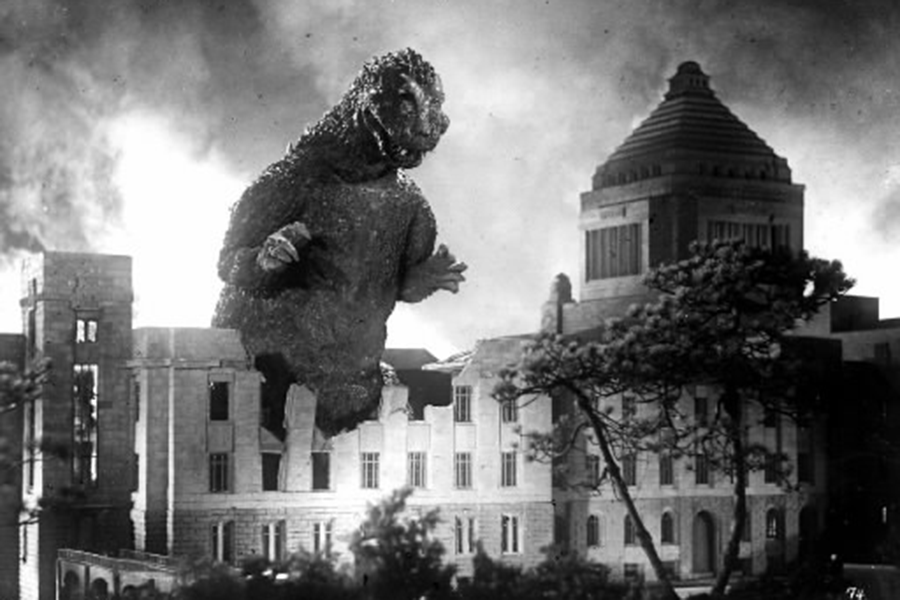Why Godzilla just got his Japanese passport
Loading...
If you can’t eat ‘em, join ‘em. Godzilla, Japan’s very own city-stomping monster and anti-nuclear symbol, has accepted both citizenship and a job as an official tourism ambassador for Tokyo's Shinjuku ward in Japan this week.
Shihoko Goto, senior Northeast Asia associate at the Woodrow Wilson Center's Asia Program, says in an interview that there’s a great deal of cultural significance to having this particular non-verbal, building-smashing mutation as a front-monster.
While Americans may view Godzilla as entertainment, Ms. Goto says “the Japanese have a much deeper, broader cultural bond” to the creature that has been both the terror and savior of Tokyo.
“He’s not just out to destroy,” she says. “He’s out to save the day and he has feelings too, even if he can’t verbalize them. He’s that lovable bad guy. There are lots of casualties, but at the end of the day you root for these unlikely protagonists.”
Goto adds, “Godzilla symbolizes the good old days of Japan on the upswing. It was a time when there seemed no limits to what the Japanese could achieve. Godzilla’s appeal today goes across generations, from the original versions, to Hollywood reinterpretation to animation.”
“It puts Japan on the map in a very positive way and there are a number of [reasons] why this is really powerful. He actually symbolizes Japan’s opposition to nuclear power and nuclear testing,” she adds.
Ms. Goto points out that “Japan has been a victim of not one, but two nuclear bombs.”
On August 6, 1945, during World War II the world’s first deployed atomic bomb was dropped over the Japanese city of Hiroshima. The explosion wiped out 90 percent of the city killing 80,000 people. Radiation exposure killed tens of thousands more in the ensuing months. Three days later, a second atomic bomb was dropped on Nagasaki, killing an estimated 40,000 people.
“So they [the Japanese] have an insight into the horrors, and one of the horrors is it can wreak havoc on nature,” she says. “And behold! Here we have Godzilla, the result of nuclear testing. And of course, he’s angry, really angry.”
Godzilla’s citizenship certificate states: “Reason for special residency: Promoting the entertainment of and watching over the Kabuki-cho neighborhood and drawing visitors from around the globe in the form of the Godzilla head built atop the Shinjuku TOHO Building.”
His birthdate is listed as the date of his first film’s premièr, April 9, 1954. Previous visits to Shinjuku Ward include: "Godzilla" (1984), "Godzilla vs. King Ghidorah" (1991), "Godzilla 2000 Millennium" (1999).
“I think people always just assumed he had citizenship, but now it’s official,” Goto says.
Paul Jaffe, New York representative for Japan Intercultural Consulting, says in an interview that now, more than four years after the March 2011 triple meltdowns at Tokyo Electric Power Co.’s Fukushima No. 1 Nuclear Power Plant, the debate over nuclear power has become so divisive that some may question this move.
“On one level It may be a symbolic representation of nuclear power as friendly rather than scary. Others, more disturbed by the damage done to property, communities, health, and life by the Fukushima disaster may see this as cynical,” Jaffe says. “Now you have Godzilla, who is of nuclear origin being befriended. It makes it a more interesting issue given that backdrop.”
However, Jaffe’s positive take on Godzilla’s new role is that the monster is a national symbol of innovation.
“It’s one of the first things from Japan that became a worldwide phenom. It was followed by many things but for the movie industry it was a kind of groundbreaking ancestor of Japan culture becomes world culture,” Jaffe says.
Film and animation are subtle ways of exporting Japanese culture to the world. According to Monocle magazine, Japan is the fourth-strongest in the world when it comes to so-called 'soft power.'
Goto adds that, “Japan has always leveraged animation as part of its soft power approach to diplomacy. Hello Kitty is a former tour ambassador. Doraemon [Gadget Cat from the Future] is another popular cartoon that exports Japanese culture to see how kids eat, where they live, and you can say that about Godzilla too in the earlier films shot in Japan.”
Overall, Godzilla represents nature’s way of striking back when mankind violates nature.
Says Goto, “It’s a word of caution of man becoming too arrogant and believing too much in the power of science.”








